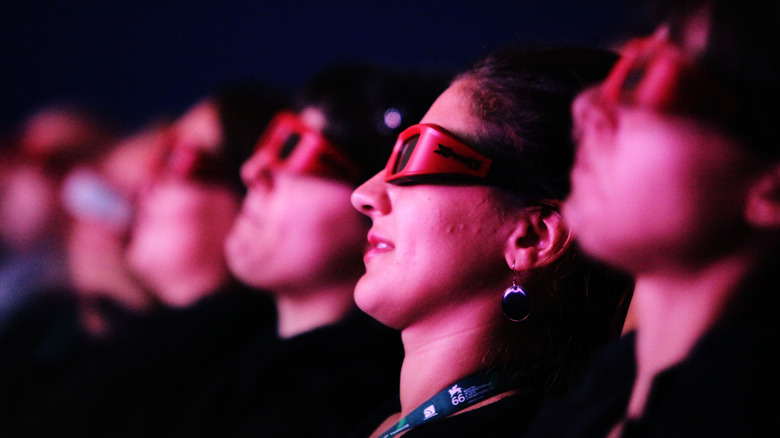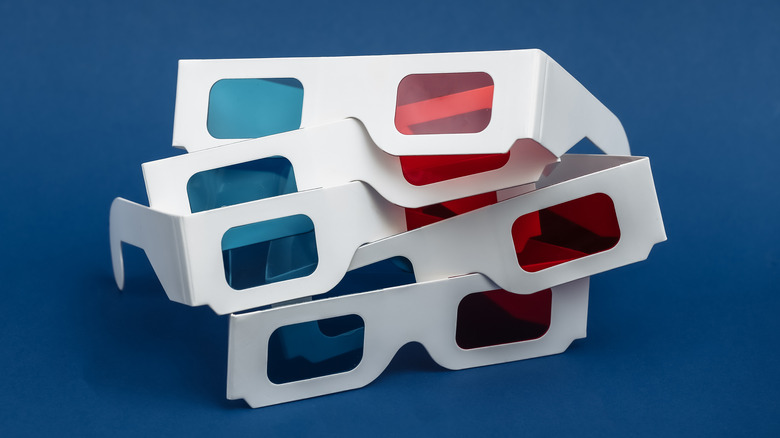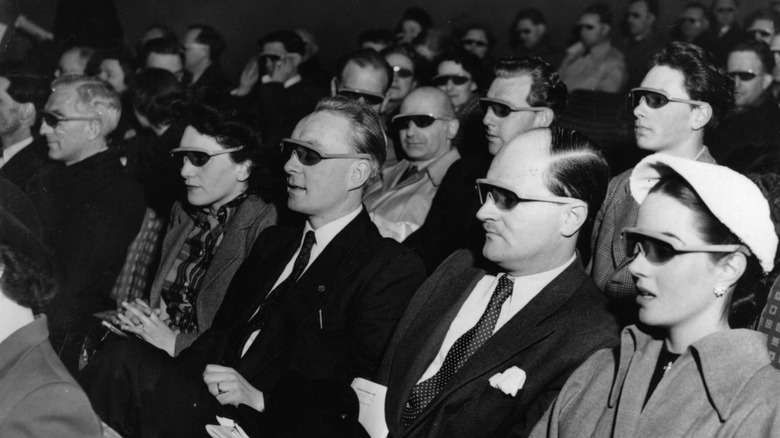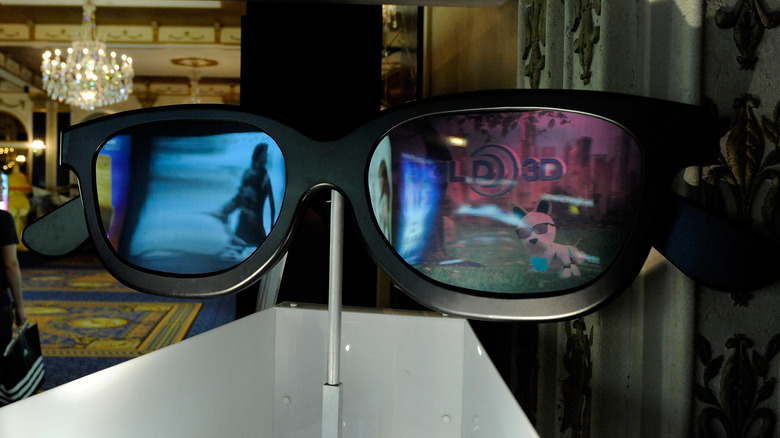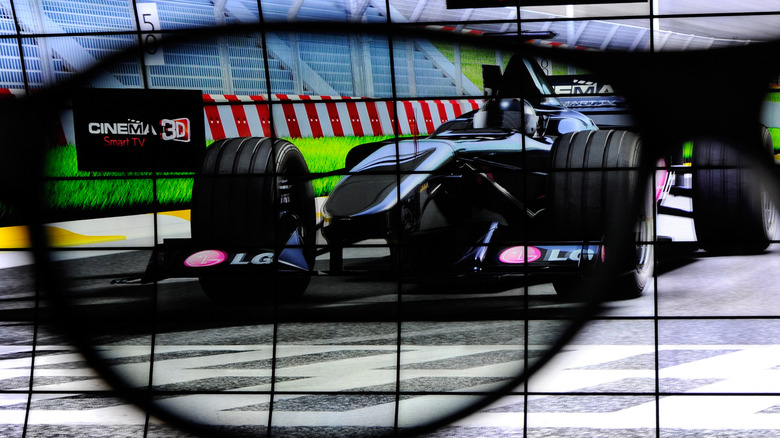This Is How 3D Glasses Really Work
More and more, 3D glasses are becoming a common part of the 21st-century media landscape. 3D technology may not be the dominant player when it comes to TV and film but it's common enough that you could buy a 3D television today at the box store of your choice or watch a major motion picture release in 3D at a local cinema.
TV and film are very different mediums when it comes to production values, the types of stories told, and the technology used, but no matter how you consume your 3D entertainment, the principles behind it are the same. Whether you're watching on the small screen or the silver screen, you're going to be wearing glasses because, in order to trick the brain into interpreting a flat image as a 3D object, you have to show a different image to each eye. The lenses of 3D glasses work hand-in-hand with the TV or projector to make sure each eye gets the proper image to give the appearance of depth.
How does depth perception work?
We use a number of cues to figure out how far away an object is. The most basic are categorized as monocular cues because they don't rely on both eyes to make an estimation of relative distance between objects. These kinds of cues are captured by the single lenses of typical cameras and are translated perfectly to the screen. Examples of monocular cues are parallax (where objects that are further away appear to move slower than objects that are nearer) and occlusion (where objects that are closer can block our view of objects that are further away), according to All About Vision.
Some cues can't be recreated with cameras and glasses. These cues happen when we use the muscles that control our eyes: oculomotor cues. When our eyes look at a faraway object, they tend to turn inwards, a signal our brain uses to let us know it's far away. Likewise, when we contract muscles to focus on an object, it's another cue to our brain that it's closer or further away.
The depth cue that 3D glasses rely on to simulate depth is a binocular cue and it's called disparity. The fact that our eyes are a few inches apart means that each one perceives a slightly different image. Our brains use the differences between those two images to produce an estimation of 3D space.
The birth of 3D film
Perhaps the oldest form of 3D glasses are those with red and blue lenses. This technique of simulating 3D imagery is called anaglyph 3D. With this technique, filmmakers would film with two cameras, each with a red or blue filter, and set eye width apart. Cinemas would likewise project with two projectors producing a blurry mess on the screen that only resolves when wearing the red and blue glasses (via Science ABC).
Anaglyphs got their start in the 19th century as simple drawn images but by the end of the century, the first motion pictures had been made. In 1922, the first anaglyphic commercial movie was released marking the high point of anaglyphic motion pictures (via The Creative Hagja). Its initial popularity soon faded but movies are still being released in anaglyph 3D — we're looking at you "The Adventures of Shark Boy and Lava Girl" (via Little White Lies).
Maybe the most surprising place where anaglyph images survive is in the sciences. NASA and the USGS regularly release images of the Earth, Moon, and Mars in 3D.
Polarizing glasses
One of the problems with anaglyph images is their limited color palette. This problem was overcome in the '30s with the invention of polarizing films that only allowed light of a certain polarity to pass through them. Unlike the anaglyphic technique which coherently displayed two images simultaneously by filtering out certain colors, the polarization technique could display full-color images (via The New York Times).
The movies were shown using two projectors with polarizing filters over the lenses. The filters had to be offset precisely 90 degrees in order to ensure that the pairs of images were only visible to one eye. The movies also had to be projected onto a special metallic screen so the polarized light could be reflected back to the audience. The audience itself had to be positioned correctly as well. If they were too far off-center from the projector or tilted their head wrong, the images could blend together or be invisible. Further complicating matters, both projectors had to be run in perfect synchronization to prevent headaches and discomfort for the viewers (via 3D Film Archive).
Despite these not-insignificant obstacles, full-color 3D films flourished for a brief period in the '50s. Once the novelty wore off, however, the complicated logistics of showing these movies were too much for theater operators and the fad disappeared as fast as it had arrived.
Going in circles
The current market leader of 3D cinema is RealD 3D. With over 10,000 screens in the U.S., it controls over 90% of the 3D market (via Variety). One of the major differences between RealD and the 3D that came before it is how it makes use of polarized light. The previous method used linearly polarized light, so if you were out of alignment with the projector, you had issues watching the movie. Modern methods use circularly polarized light which allows for more angles of view without the issues (via How Stuff Works).
Another innovation of the RealD system is its use of a single digital projector. In place of the second projector, the frames for the left and right eye are projected one after the other while a polarization switch rapidly alternates between projecting images in clockwise and counterclockwise polarity. If you've seen a major motion picture in 3D during the last 15 years, this is most likely the technology used.
Don't blink
Dual polarity displays are all well and good for movie theaters that can afford to make investments in expensive equipment for their 3D movies, but most of the CRT, plasma, and LCD screens in our houses can't emit two polarities of light. To get around this problem, home-based 3D systems use a method known as active 3D.
At its heart, this method is the same as the others: show a different image to each eye. Where it differs is how it accomplishes this. The glasses in active systems have LCD lenses that rapidly turn off and on in synchrony with the television or monitor which alternates between images for the left eye and the right eye. That means when the image for the left eye is on screen, the lens for the right eye is blacked out and vice versa (via Sony).
3D-enabled TVs and gaming systems are still available to purchase but they aren't a must-have item anymore. This is likely due to the additional cost of a 3D-capable TV and the inconvenience of the larger glasses (via CNET).
